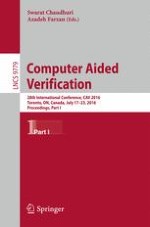2016 | Buch
Computer Aided Verification
28th International Conference, CAV 2016, Toronto, ON, Canada, July 17-23, 2016, Proceedings, Part I
herausgegeben von: Swarat Chaudhuri, Azadeh Farzan
Verlag: Springer International Publishing
Buchreihe : Lecture Notes in Computer Science
